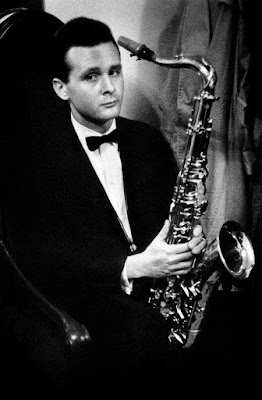Stanley Getz (February 2, 1927 – June 6, 1991) was an American jazz saxophone player. Getz was known as "The Sound" because of his warm, lyrical tone, his prime influence being the wispy, mellow timbre of his idol, Lester Young. Coming to prominence in the late 1940s with Woody Herman's big band, Getz is described by critic Scott Yanow as "one of the all-time great tenor saxophonists". Getz went on to perform in bebop, cool jazz and third stream, but is perhaps best known for popularizing bossa nova, as in the worldwide hit single "The Girl from Ipanema" (1964).
 Born in 1927, Getz was the son of Ukrainian parents who had fled the pogroms. He was raised in the Bronx, in New York, and took up saxophone when he was 13 years old, having already demonstrated that he had a terrific ear for music by picking out tunes on the piano or the harmonica and committing a raft of Benny Goodman’s clarinet solos to memory.
Born in 1927, Getz was the son of Ukrainian parents who had fled the pogroms. He was raised in the Bronx, in New York, and took up saxophone when he was 13 years old, having already demonstrated that he had a terrific ear for music by picking out tunes on the piano or the harmonica and committing a raft of Benny Goodman’s clarinet solos to memory. Getz had the opportunity to play in a variety of major swing big bands while a teenager due to the World War II draft. He was with Jack Teagarden (1943) when he was just 16, followed by stints with Stan Kenton (1944-1945), Jimmy Dorsey (1945), and Benny Goodman (1945-1946); he soloed on a few records with Goodman. Getz, who had his recording debut as a leader in July 1946 with four titles, became famous during his period with Woody Herman's Second Herd (1947-1949), soloing (along with Zoot Sims, Herbie Steward, and Serge Chaloff) on the original version of "Four Brothers" and having his sound well-featured on the ballad "Early Autumn." After leaving Herman, Getz was (with the exception of some tours with Jazz at the Philharmonic) a leader for the rest of his life.
During the early '50s, Getz broke away from the Lester Young style to form his own musical identity and he was soon among the most popular of all jazzmen. He discovered Horace Silver in 1950 and used him in his quartet for several months. After touring Sweden in 1951, he formed an exciting quintet that co-featured guitarist Jimmy Raney; their interplay on uptempo tunes and tonal blend on ballads were quite memorable. Getz's playing helped Johnny Smith have a hit in "Moonlight in Vermont"; during 1953-1954, Bob Brookmeyer made his group a quintet and, despite some drug problems during the decade, Getz was a constant poll winner.
After spending 1958-1960 in Europe, the tenorman returned to the U.S. and recorded his personal favourite album, Focus, with arranger Eddie Sauter's Orchestra. Then, in February 1962, Getz helped usher in the bossa nova era by recording Jazz Samba with Charlie Byrd; their rendition of "Desafinado" was a big hit.
During the next year, Getz made bossa nova-flavored albums with Gary McFarland's big band, Luiz Bonfá, and Laurindo Almeida, but it was Getz/Gilberto (a collaboration with Antonio Carlos Jobim and João Gilberto) that was his biggest seller, thanks in large part to "The Girl from Ipanema" (featuring the vocals of Astrud and João Gilberto).
 |
| Astrud Gilberto & Stan Getz |
 After utilizing pianist Joanne Brackeen in his 1977 quartet, Getz explored some aspects of fusion with his next unit which featured keyboardist Andy Laverne. Getz even used an Echoplex on a couple of songs but, despite some misfires, most of his dates with this unit are worthwhile. However, purists were relieved when he signed with Concord in 1981 and started using a purely acoustic backup trio on most dates. Getz's sidemen in later years included pianists Lou Levy, Mitchell Forman, Jim McNeely, and Kenny Barron. His final recording, 1991's People Time, (despite some shortness in the tenor's breath) is a brilliant duet set with Barron.
After utilizing pianist Joanne Brackeen in his 1977 quartet, Getz explored some aspects of fusion with his next unit which featured keyboardist Andy Laverne. Getz even used an Echoplex on a couple of songs but, despite some misfires, most of his dates with this unit are worthwhile. However, purists were relieved when he signed with Concord in 1981 and started using a purely acoustic backup trio on most dates. Getz's sidemen in later years included pianists Lou Levy, Mitchell Forman, Jim McNeely, and Kenny Barron. His final recording, 1991's People Time, (despite some shortness in the tenor's breath) is a brilliant duet set with Barron. Getz died of liver cancer in June 6, 1991. His body was cremated and the ashes scattered at sea, off the coast of Malibu, California.
 Throughout his career Getz recorded as a leader for Savoy, Spotlite, Prestige, Roost, Verve, MGM, Victor, Columbia, SteepleChase, Concord, Sonet, Black Hawk, A&M, and EmArcy among other labels (not to mention sessions with Lionel Hampton, Dizzy Gillespie, and Gerry Mulligan) and there are dozens of worthy records by the tenor currently available on CD.
Throughout his career Getz recorded as a leader for Savoy, Spotlite, Prestige, Roost, Verve, MGM, Victor, Columbia, SteepleChase, Concord, Sonet, Black Hawk, A&M, and EmArcy among other labels (not to mention sessions with Lionel Hampton, Dizzy Gillespie, and Gerry Mulligan) and there are dozens of worthy records by the tenor currently available on CD. (Info edited mainly from All Music with help from Wikipedia)


